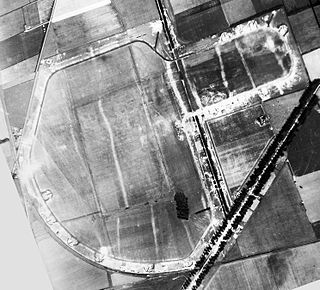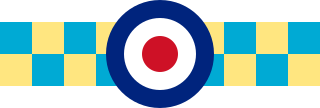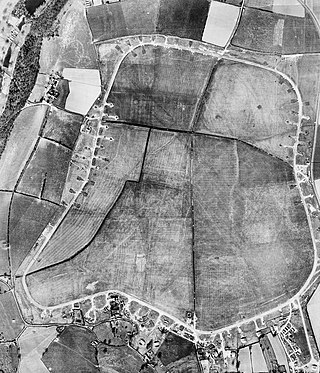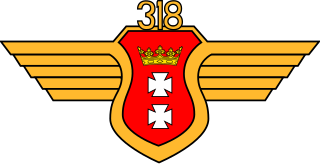The List of Hawker Typhoon operators lists the countries and their air force units that have operated the aircraft:
Contents
- Operators
- Australia
- Canada
- New Zealand
- United Kingdom
- See also
- References
- Notes
- Citations
- Bibliography
The List of Hawker Typhoon operators lists the countries and their air force units that have operated the aircraft:






Number 6 Squadron of the Royal Air Force operates the Eurofighter Typhoon FGR.4 at RAF Lossiemouth. It was previously equipped with the SEPECAT Jaguar GR.3 in the close air support and tactical reconnaissance roles, and was posted to RAF Coltishall, Norfolk until April 2006, moving to RAF Coningsby until disbanding for the first time in its history on 31 May 2007. The squadron officially reformed as a Typhoon squadron on 6 September 2010. No. 6 Squadron is unique in having two Royal standards, having been awarded its second one by King Abdullah I of Jordan in October 1950 due to its long period of service in the Middle East.

Tain Air Weapons Range is a Ministry of Defence air weapons range on the Dornoch Firth near Tain in Scotland. Royal Air Force aircrews from RAF Lossiemouth are trained in air weaponry on the range, along with NATO aircrew.

Royal Air Force Snailwell or more simply RAF Snailwell is a former Royal Air Force station located near to the village of Snailwell, Cambridgeshire, located 3 miles (4.8 km) north of Newmarket, Suffolk, England.

No. 683 Squadron RAF was a photo-reconnaissance squadron of the Royal Air Force during the Second World War and from August 1950 to November 1953.

No. 354 Squadron RAF was a general reconnaissance squadron of the Royal Air Force during the Second World War.

No. 245 Squadron was a squadron of the Royal Air Force. It flew as an anti-submarine squadron during World War I and as a fighter squadron during World War II. After the war it was first a jet-fighter squadron and its last role was as a radar-calibration unit.

No. 257 Squadron RAF was a flying squadron of the Royal Air Force active during the First World War, the Second World War and also the Cold War. It was finally disbanded in December 1963.
No. 193 Squadron RAF was a fighter squadron of the Royal Air Force during World War II.

Army Aviation Centre (AAC) Middle Wallop is a British Army airfield located near the Hampshire village of Middle Wallop, used for Army Air Corps training. The base hosts 2 (Training) Regiment AAC and 7 (Training) Regiment AAC under the umbrella of the Army Aviation Centre. 2 (Training) Regiment performs ground training; 7 (Training) Regiment trains aircrew on AAC aircraft after they complete basic training at RAF Shawbury.

No. 266 (Rhodesia) Squadron RAF was a squadron of the Royal Air Force.
Royal Air Force Fairwood Common or more simply RAF Fairwood Common is a former Royal Air Force Sector station located at Fairwood Common on the Gower Peninsula to the west of Swansea. It is now the location of Swansea Airport.

349th Squadron is a fighter squadron in the Air Component of the Belgian Armed Forces. The squadron traces its origins to No. 349 (Belgian) Squadron of the Royal Air Force, founded in 1942 as part of the Free Belgian forces during World War II. It was transferred to the re-established Belgian Air Force in 1946, together with 350th Squadron. Considered an "honorary" squadron, it retained its original name and numbering and has been flying under the Belgian flag ever since. Today it is part of the 10th Tactical Wing, operating the F-16 Fighting Falcon from Kleine Brogel airbase.

Royal Air Force Zeals or more simply RAF Zeals is a former Royal Air Force station in Wiltshire, sited to the north of the village of Zeals, next to the village of Stourton and the Stourhead estate.

No. 239 Squadron RAF was an anti-submarine squadron of the Royal Air Force during World War I. During World War II the squadron performed as an army co-operation squadron and later as a night intruder unit. After the war the squadron was disbanded.
No. 169 Squadron RAF was a tactical reconnaissance and later a night intruder squadron of the Royal Air Force during World War II.

Royal Air Force Hawkinge or more simply RAF Hawkinge is a former Royal Air Force station located 13.23 miles (21.29 km) east of Ashford, 2.2 miles (3.5 km) north of Folkestone, Kent and 7.1 miles (11.4 km) west of Dover, Kent, England. The airfield was used by both the Royal Flying Corps and the Royal Air Force during its lifetime and was involved during the Battle of Britain, as well as other important aerial battles during the Second World War and the early stages of aerial usage in war in the First World War.

Royal Air Force Matlaske or more simply RAF Matlaske is a former satellite station of the Royal Air Force to RAF Coltishall, situated near Matlaske in Norfolk, England.

443 Maritime Helicopter Squadron is a Canadian Armed Forces helicopter squadron under the Royal Canadian Air Force (RCAF), located on Vancouver Island, British Columbia. It was originally a Second World War RCAF squadron that operated as part of RAF Fighter Command in Europe with the Supermarine Spitfire.
No. 137 Squadron RAF existed briefly as a day bomber unit in World War I but never became operational. During World War II it flew as one of the two Whirlwind squadrons before converting to Hurricane Mk.IV fighter-bombers and later the Hawker Typhoon in the same role. The squadron was disbanded in August 1945.

No. 318 "City of Gdańsk" Polish Fighter-Reconnaissance Squadron (Polish: 318 Dywizjon Myśliwsko-Rozpoznawczy Gdański") was a Polish tactical reconnaissance aircraft squadron formed in Great Britain as part of an agreement between the Polish Government in Exile and the United Kingdom in 1940. It was one of several Polish squadrons fighting alongside the Royal Air Force (RAF) during World War II.